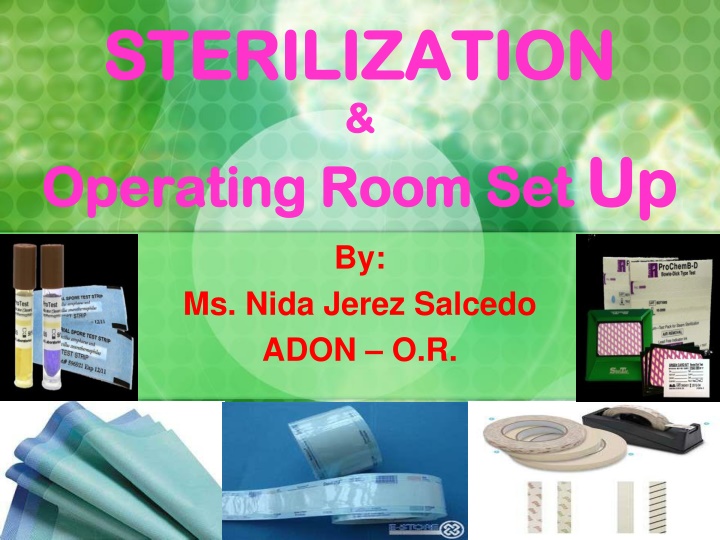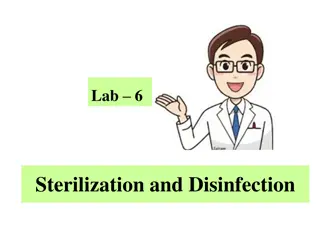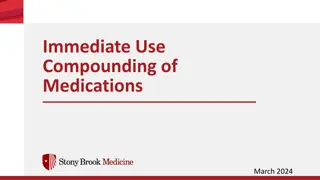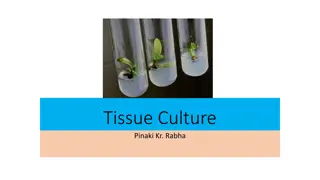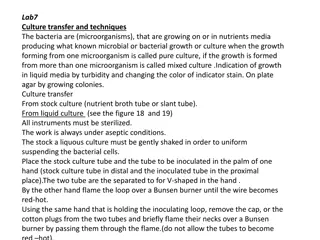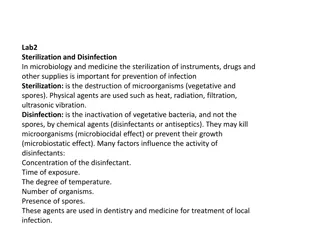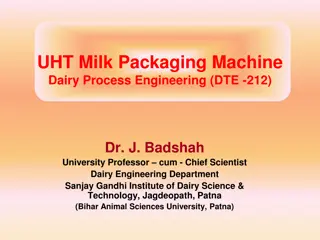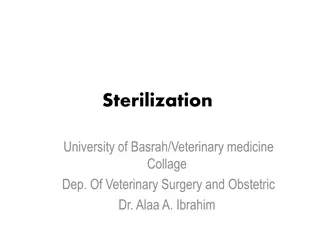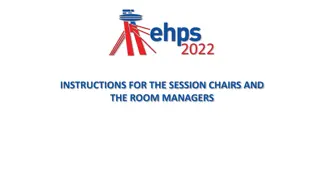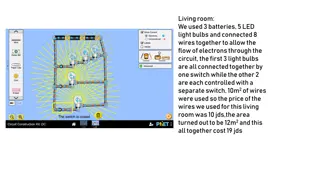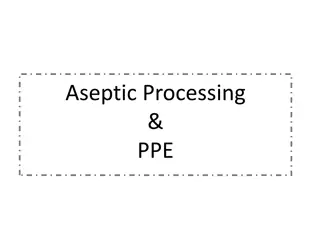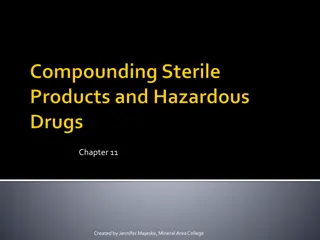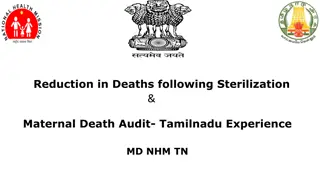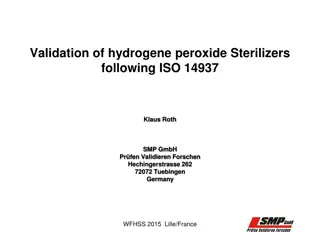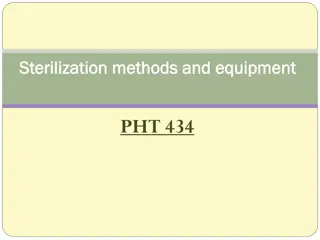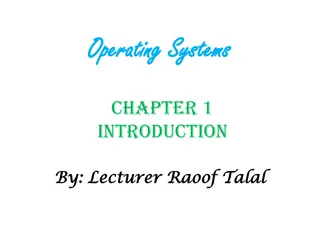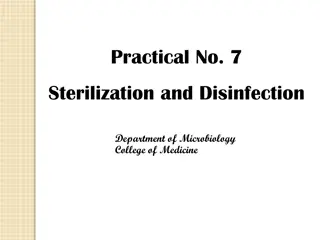Sterilization and Aseptic Techniques in Operating Room Setup
Explore the methods and processes of sterilization, principles of aseptic techniques, and operating room setup for patient safety. Learn terminologies related to sterilization, asepsis, sepsis, antiseptics, and disinfection to ensure a sterile environment for medical procedures.
Download Presentation

Please find below an Image/Link to download the presentation.
The content on the website is provided AS IS for your information and personal use only. It may not be sold, licensed, or shared on other websites without obtaining consent from the author.If you encounter any issues during the download, it is possible that the publisher has removed the file from their server.
You are allowed to download the files provided on this website for personal or commercial use, subject to the condition that they are used lawfully. All files are the property of their respective owners.
The content on the website is provided AS IS for your information and personal use only. It may not be sold, licensed, or shared on other websites without obtaining consent from the author.
E N D
Presentation Transcript
STERILIZATION STERILIZATION & & Operating Room Set Operating Room Set Up Up By: Ms. Nida Jerez Salcedo ADON O.R.
Main Objectives: To be able To acquire knowledge and understanding on the different methods of sterilization as well as the sterilization processes. To know & get familiarized with the principles of aseptic techniques & apply them in the clinical areas & Operating Room.
Table of Contents: Methods of Sterilization Physical Methods Cool Chemical Methods Liquid Chemicals Other Methods Sterilization Processes Preparation of items before sterilization Steam Sterilization Process Testing the Effectiveness of the Autoclave Storage of Sterile Packages Principles of Aseptic Techniques-O.R. Set Up (Sterile Field) Operating Room Set Up for Patient Safety
Terminologies Sterilization-process by which all living microorganisms both pathogenic & non- pathogenic including spores are killed. Sterile-absence of all microorganisms including bacteria, spores and viruses. Asepsis- freedom from infection or the absence of microorganisms that cause diseases.
Terminologies Sepsis- generalized reaction to pathogenic microorganism which is evident clinically by signs of inflammation & febrile conditions Aseptic Techniques-practices that restrict microorganisms in the environment, equipment, supplies & prevention of the normal body flora from contaminating the surgical wound. (Method by which contamination with microorganisms is prevented).
Terminologies Contamination-introduction of microorganisms to a sterile field. Antiseptics-substances that renders microorganisms on living tissue inactive by preventing their growth. Used to disinfect body surfaces, skin & tissue. Inhibits the growth of endogenous bacteria. (Combat sepsis)
Terminologies Disinfection-process by which renders inanimate objects free of pathogenic bacteria. Disinfectants-agents that kill all growing or vegetative forms of microorganisms thus completely eliminating them from inanimate objects. Contamination-introduction of microorganisms to a sterile field.
The prevention of infection in health care areas is largely dependent on the following: Rigorous adherence to the principles of aseptic techniques by all personnel who performs any invasive procedures on patients. Sterility of all items directly used in such procedures. Disinfection of all surfaces & other items in the immediate environment. Other methods Prevention of SSI-Bundle of Care
Remember: There is no degree of sterility. An item is either sterile or non- sterile. It can never be relatively sterile.
Take Note: Surgical instruments, devices & heat sensitive items are sterilized by the method recommended by the manufacturer. No sterile disposable items designed for single use should be reprocessed. Sterilizing agent should be in contact with every part / surface of the item to be sterilized at specific period of time & temperature.
Methods of Sterilization: Physical Methods: 1. Dry Heat-Hot air ovens, infra red ovens. 2. Moist heat- Steam Autoclave-(Available in KKUH) Cool Chemical Methods: 1. E.O. Sterilizer 2. Plasma Sterilizer (Sterrad)- (Available in KKUH) 3. Liquid Chemicals Other Methods
Physical Method: Moist heat, at raised atmospheric pressure Steam sterilization (steam under pressure) - most inexpensive & effective method of sterilization. Steam under pressure permits permeation of moist heat to porous substances by condensation & results in destruction of all microbial life. . Ex. Steam autoclave Method used for sterilizing surgical instruments, dressing, drapes, swabs, laps sponges & culture media.
Steam Autoclave An autoclave is a closed chamber in which items or objects are subjected to steam at high pressure & temperature above 100 C.
Types of Autoclaves: Downward Displacement Autoclave- Air is removed in two stages & sterilization is effected by pure steam. Minimum exposure time required for sterilizing instruments is 50 minutes at 131 C or 60 minutes at 136 C.
Types of Autoclaves: High Vacuum / High Pressure Autoclave- Air is removed by powerful pump. Steam penetrates the load & very rapid sterilization of dressings, instruments, raytec swabs, lap sponges, other surgical items & packs is possible in 30 to 40 minutes at 134 C. (Available in KKUH)
Preparation Of Items Before STERILIZATION 1. Decontamination 2. Disassembly 3. Washing 4. Drying 5. Packing 6. Loading in sterilizer
THE STEAM STERILIZATION PROCESS FIVE DISTINCT PHASES: PHASE I - Loading phase - in which the objects or packs are loaded in the sterilizer. PHASE II - Heating phase - in which the steam is brought to proper temperature & allowed to penetrate through the objects in the chamber. PHASE III - Destroying phase or time temperature cycle - in which all microbial life is exposed to the killing effect of the steam.
THE STEAM STERILIZATION PROCESS PHASE IV - Drying and cooling phase - in which the objects are dried & cooled then, filtered air is introduced into the chamber, door is opened & packs are removed stored. PHASE V - Testing phase - in which the efficiency of the sterilization process is checked. All mechanical parts of sterilizers, including gauges, steam lines & drains should be periodically checked by a competent biomed engineer.
MAKING OF STERILE PACKS Should have the following external indications showing that they have been processed: Autoclave tapes show a pack that has been through a sterilization cycle & should be visible outside every pack sterilized. Autoclave tape is designed black when specified temperature is reached. Must be labeled as to its contents with the processing date, autoclave used & load number. This assists locating processed items in case of recall.
STORAGE OF STERILE PACKS Sterile packs / sets should be left untouched & allowed to be cooled before storage to avoid condensation inside. Must be handled as little as possible to reduce the risk of contamination.
STORAGE OF STERILE PACKS Sterile packages should be stored on open shelves. The lowest shelf should be 8 to 10 inches off the floor. The highest shelf should be 18 inches from the ceiling. All shelves should be at least 2 inches from the walls.
STORAGE OF STERILE PACKS Either good for 30 days or 6 months to one year depending on how the packages are wrapped & what type of wrappers used. Shelf life - refers to the length of time a package maybe considered sterile. Sterile packages must be stored and issued in correct order. Traceability (Tracking System)
STORAGE OF STERILE PACKS Storage room-subjected to regular adequate pest control to prevent contamination from rodents, ants & cockroaches. Traffic is restricted to CSSD personnel & trainees only. One flow
Causes of failure to produce a sterile load Faults & errors in the autoclave Poor quality steam Way it is operated Failure to remove air & condensate Faulty gauges & timings Leaking door seals Inadequate air filter Excessive layers of wrapping materials Large packs, torn & wet packs
Methods of Testing the Effectiveness of Autoclaves: Mechanical- chart & gauges usually carried out by Biomed Engineer. Chemical- by the use of autoclave tapes, strips and card. A daily test in an empty chamber using a heat sensitive tape. This is for high vacuum/high pressure autoclaves. Ex. Bowie Dick Test Pack- a pack with a chemical indicator both outside & inside to verify that steam has penetrated the pack & to test air leaks. Biological
Biological Indicator- Biological Spore Testing To test autoclaves regularly with Geobacillus stearothermophilus, which is one of the most heat tolerant species of bacteria. If sterilization in an autoclave does not destroy the Geobacilus spores, the autoclave is not working properly. http://www.atssupplies.com/__CategoryImage/5_27_2011_5_14_49_AM_297.png
Testing the Effectiveness of Steam Autoclave: First- Run it empty for one cycle. (Dummy Run) to warm up the machine. Second- Put inside in the middle of the chamber, the Bowie Dick Test Pack and run it again and finish the whole cycle. Oh high pressure- to test leaks and presence of air. (Yellow turns black) Third- Load the items & trays for sterilization ( little bit lower pressure). It is done once daily. Fourth- Live Organism- done once in every Sunday morning in CSSD, KKUH.
COLD METHOD-Chemicals Ethylene Oxide (EO)- *Well established technique for sterilizing heat sensitive articles. *Colorless gas * Exposure period of 5 to 7 hours is necessary for complete E.O. sterilization. *Temperature for sterilizing is 21 C to 60 C (70 F to 140 F).
E.O. Sterilizer Used for sterilizing vascular & bone grafts, delicate instruments, plastic articles such as disposable syringes,bacteriological media & vaccines.
Ethylene Oxide (EO) Chemical indicators for EO should be used with each pack . Gas sterilizers should be checked once a week with commercial preparation spores, usually Bacillus Atropheus. Requires 6-8 hours of aeration.
DISADVANTAGES OF EO Lengthy process with long aeration periods. Expensive & more complex process. Produce serious burns on exposed skin. Insufficiently aerated materials can cause irritation, burns of body tissues. Toxic & may cause Cancer. *Precautions should be taken to protect personnel.
Plasma Sterilizer Plasma Autoclave (Sterrad)- *Low Temperature Hydrogen Gas Sterilizers. *Used to sterilize delicate instruments that are heat & moisture sensitive, such as micro instruments, cameras, scopes & light cords. *Gentle patented sterilization process with the use of hydrogen peroxide & generation of low temperature gas plasma. *Spore testing should be performed at the same interval as testing of other sterilizers.
Plasma Sterilization 104 F-131 F (40 C-55 C). 45 minutes to I hour. Advantages of plasma sterilization include speed, safety of use, & no aeration. Five phases to the Sterrad Plasma sterilization cycle: vacuum, injection, diffusion, plasma, vent.
LIQUID CHEMICAL STERILIZATION Liquid chemo sterilizers can destroy all forms of microbial life including bacterial, fungal spores, tubercle bacilli & viruses. Can be used for sterilization when steam, gas or dry heat is not indicated or available.
Common Liquid Chemicals - Capable of causing Disinfection / Sterilization. Aqueous Formaldehyde- Oldest chemo sterilizers known to destroy spores; rarely used due to its pungent odor. Aqueous Glutaraldehyde- Colorless liquid chemical with pungent odor. (CIDEX) *Short soaking period( 20 minutes-30 minutes) only provides disinfection of instruments. *Complete immersion in activated glutaraldehyde solution for 10 hours achieves sterilization. *After immersion, all surfaces of the instruments must be rinsed thoroughly with sterile water before use. *Any immersion of less than 10 hours must be considered as only as disinfection(Spores not killed. *Toxic & can cause nasal ( respiratory mucosa), eye & skin irritation.
Common Liquid Chemical Disinfectants OPA Cidex-(0.55% ortho-phthalaldehyde)-Clear, pale-blue liquid (pH, 7.5), contains 0.55%the non-glutaraldehyde solution for disinfection of flexible endoscopes and other medical devices. Alcohol- 70 % Ethyl Alcohol & 70% Isopropyl Alcohol- Effective & rapidly acting disinfectants. *Alcohol gel preparations today have been introduced & long standing effect, fast in action & more users friendly.( Hand Antiseptics) Chlorexidine- Skin antiseptic & highly active against vegetative bacteria. Hypochlorite- Broad spectrum chlorine disinfectant effective against viruses, fungi, bacteria & spores. *Disinfectant of choice against hepatitis B virus.
Other Methods of Sterilization: Gamma Radiation Gamma Radiation-Radioactive material, such as a Cobalt-60 source, emits radiation(gamma rays). Gamma Radiation effectively kills microorganisms. Used on commercial basis for the sterilization of a wide variety of pre-packaged hospital items and devices. Total sterilizing time is measured in days.
Flash Sterilization Flash sterilization should be used in selected clinical situations & in a controlled manner. *Use of flash sterilizer should be kept to a minimum & only for emergency use. Flash sterilization should not be used as a substitute for proper sterilization methods. Flash sterilization should not be used for implantable devices.
Principles of Aseptic Techniques By: Ms. Nida J. Salcedo ADON-O.R. For O.R. Set Up (Sterile Field)
Aseptic techniques are sets of practices performed under careful, controlled conditions in order to prevent contaminations of pathogens. Most strictly applied in the O.R. because of direct & extensive disruption of skin & underlying tissues. Practices that ensure safe & effective ways in establishing & maintaining sterile field in which surgery can be performed safely. Aseptic techniques help to prevent surgical site infection.
All items used within the sterile field must be sterile. Point of emphasis: Sterile items presented to the sterile field must be checked for: * Package Integrity * Expiration Date * Chemical Process Indicator Tears in barriers & expired sterilization dates are considered breaks in sterility.
Use of unsterile items contaminate the sterile field. Sterile field is created as well as sterile packages are opened as close as possible to time of actual use. Moist areas are considered sterile.
Scrubbed personnel should function within a sterile field. Surgical team is made up of: * Sterile members or scrubbed personnel- work directly in the surgical field. Ex. Surgeons, Scrub nurse, O.R. Technician * Non-sterile members or unscrubbed personnel. Ex. Anesthetists, Circulating nurses, Anesthesia Technicians, X-Ray Technician
Points of Emphasis: Surgical team members must wear the scrub suit attire, surgical cap, surgical face mask before performing surgical hand scrub. First surgical hand scrub should be at least 5 minutes & the subsequent hand, at least 2 to 3 minutes. Surgical hand scrubbing to be performed prior to donning of sterile gown & sterile gloves.
